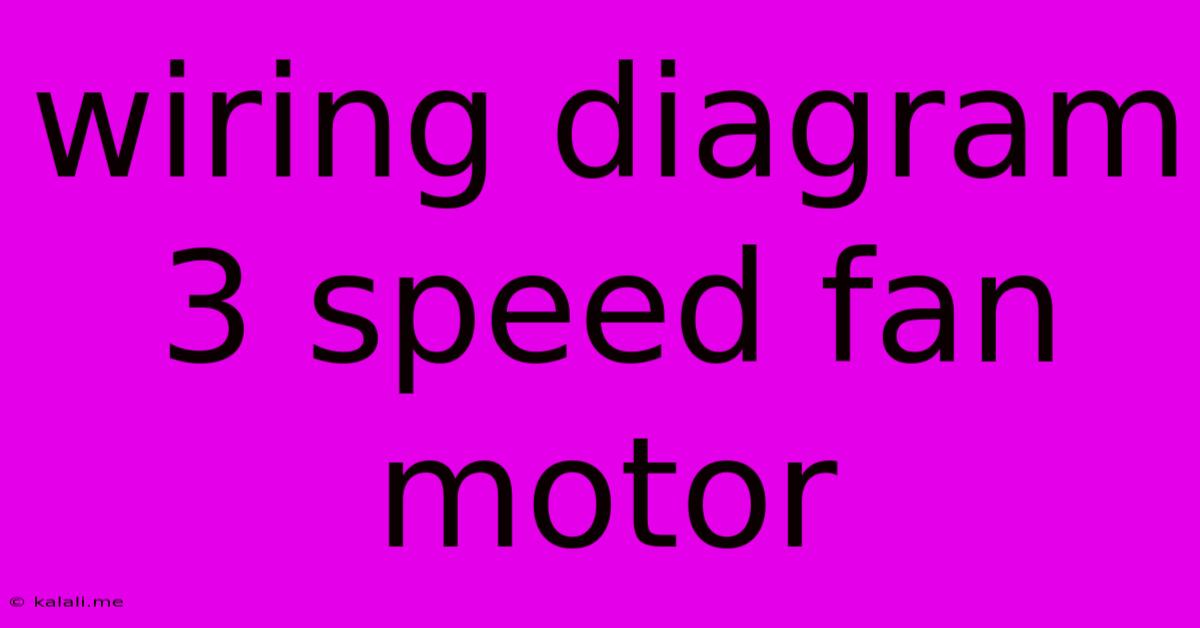Wiring Diagram 3 Speed Fan Motor
Kalali
May 30, 2025 · 4 min read

Table of Contents
Understanding 3-Speed Fan Motor Wiring Diagrams: A Comprehensive Guide
Meta Description: This guide provides a detailed explanation of 3-speed fan motor wiring diagrams, covering different configurations, troubleshooting common issues, and safety precautions. Learn how to decipher these diagrams and understand the functionality of each component.
A 3-speed fan motor, unlike its simpler single-speed counterpart, offers greater control over airflow. This versatility comes with slightly more complex wiring, often represented in a wiring diagram. Understanding this diagram is crucial for installation, maintenance, and troubleshooting. This article will break down the intricacies of 3-speed fan motor wiring diagrams, helping you navigate this seemingly complex topic.
Types of 3-Speed Fan Motor Wiring Diagrams
There isn't a single universal wiring diagram for all 3-speed fan motors. The specific configuration depends on the motor's design and the type of speed control used. Common types include:
-
Capacitor-Start, Capacitor-Run Motors: These motors use capacitors to start and run the motor at different speeds. The wiring diagram will show the connections to the capacitors, windings, and the power supply. You'll see multiple capacitors, often a start capacitor and a run capacitor, indicated in the diagram. The different speed settings are achieved by switching between different winding combinations.
-
Permanent Split Capacitor (PSC) Motors: These motors use a single capacitor for both starting and running. While simpler than capacitor-start, capacitor-run motors, their wiring diagrams still show connections to the capacitor, windings, and the speed switch. Different speed settings are again achieved by switching between winding combinations.
-
Shaded Pole Motors: These motors are typically used in smaller fans and are generally simpler to understand. Their wiring diagrams are less complex, usually only showing the connection to the power supply and the shaded pole winding. Speed control is usually achieved by varying the voltage supplied to the motor, not by switching different winding combinations like in PSC and capacitor-start/run motors.
Deciphering a 3-Speed Fan Motor Wiring Diagram
Regardless of the motor type, most diagrams will include these key elements:
-
Power Supply Terminals: Indicated as "L" (Line) and "N" (Neutral) or similar markings, these are where the main power supply connects.
-
Motor Windings: These are represented as coils or loops and are labeled accordingly (e.g., Winding 1, Winding 2, Winding 3). These windings determine the speed of the motor.
-
Capacitors (if applicable): These components are crucial for starting and running the motor efficiently and are shown as parallel lines with a curved line representing the dielectric material. Their capacitance values are often indicated.
-
Speed Switch Terminals: This is where the speed selector switch connects. The diagram shows how the switch connects to the various motor windings and capacitors to select the desired speed.
-
Common Terminal: This terminal is a shared connection point for multiple components, often simplifying the circuit.
Troubleshooting Common Issues
If your fan motor isn't working correctly, understanding the wiring diagram is vital for troubleshooting. Common problems and possible causes include:
-
No Power: Check the power supply, fuses, and circuit breaker.
-
Motor Doesn't Start: Check the capacitors for capacitance degradation, loose connections, and the integrity of the windings. A faulty speed switch is another potential culprit.
-
Motor Runs at Only One Speed: Inspect the wiring connections to the speed switch and ensure all connections are secure. A faulty switch or a problem with the windings may also be the issue.
-
Motor Overheats: This could indicate a faulty capacitor, short-circuited windings, or an overloaded motor.
Remember to always disconnect the power before attempting any repairs.
Safety Precautions
Working with electrical components can be dangerous. Always adhere to these safety precautions:
-
Disconnect power: Before any work, always switch off the power at the circuit breaker.
-
Use appropriate tools: Use insulated tools to avoid electrical shocks.
-
Consult a professional: If you're uncomfortable working with electrical circuits, it's always best to consult a qualified electrician.
By understanding the components and connections depicted in a 3-speed fan motor wiring diagram, you gain the knowledge to install, maintain, and troubleshoot your fan effectively and safely. Remember that the specific diagram will vary depending on the motor's design, but the underlying principles remain consistent. Always prioritize safety and consult a professional if you are unsure about any aspect of the process.
Latest Posts
Latest Posts
-
Can A Generac Be Upgraded To A 125amps
Jun 01, 2025
-
How To Manually Drain A Washing Machine
Jun 01, 2025
-
Where Does The Notary Stamp Go
Jun 01, 2025
-
6 Of 1 Half A Dozen Of Another
Jun 01, 2025
-
Does Yellow And Blue Make Green
Jun 01, 2025
Related Post
Thank you for visiting our website which covers about Wiring Diagram 3 Speed Fan Motor . We hope the information provided has been useful to you. Feel free to contact us if you have any questions or need further assistance. See you next time and don't miss to bookmark.